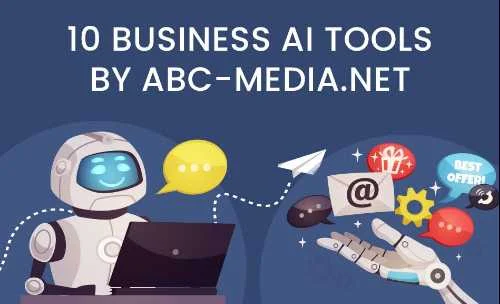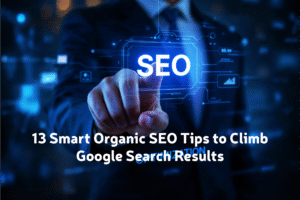10 Business AI Tools By ABC-Media.Net That Every Business Needs
Artificial Intelligence continues to evolve much quicker, and businesses have been constantly looking to adopt new technology to enhance their company processes through automation, scaling, and valuable insights. Such adoption has also piqued the interest of ABC-Media.Net in compiling a list of 10 Business AI Tools by ABC-Media.Net.
Discover these top 10 business AI tools and know their impact on your company’s operations to increase efficiency and productivity. From streamlining company processes to improved decision-making, these tools can potentially transform businesses.
Dive deep into the 10 Business AI Tools By ABC-Media.Net and read about:
1. 10 Business AI Tools By ABC-Media.Net To Automate Business Processes
2. How can businesses implement these tools
3. Conclusion
10 Business AI Tools By ABC-Media.Net To Automate Business Processes
1. Automation Solutions
2. Predictive Analytics Platforms
3. Customer Relationship Management (CRM) Systems
4. Natural Language Processing (NLP) Tools
5. Marketing Automation Platforms
6. Supply Chain Optimization Software
7. Business Intelligence (BI) Dashboards
8. Data Security Solutions
9. Image Recognition Software
10. Virtual Assistants and Chatbots
#1. Automation Solutions
Your business’s everyday tasks, such as capturing leads, sending follow-up emails, or generating invoices, can take up much of your time and prevent you from finishing them by the end of the day. Thus, you can address this issue by automating your business operation. You can do it with the assistance of an Automation solution to save ample time so your team can work on more important tasks.
Automation software is a set of applications and features that can automate repetitive tasks. It has many applications in many industries to help organizations improve operational efficiency.
Some Examples Of Predictive Analytics Platforms
1. Robotic process automation (RPA): Software robots that can perform routine tasks or business processes
2. Intelligent automation (IA): Combines RPA, AI, and ML to automate entire workflows
#2. Predictive Analytics Platforms
AI-based CRM systems enhance customer engagement and relationship management by providing personalized recommendations, predictive lead scoring, and sentiment analysis. By leveraging AI-driven insights, businesses can optimize customer interactions, foster loyalty, and drive revenue growth.
Predictive analytics can be utilized in many industries, including healthcare, finance, and manufacturing, and provides many benefits of digital marketing for small businesses. Companies can use the insights from predictive analytics to make informed decisions, identify risks and opportunities, and mitigate risk.
Some features to look for in predictive analytics platforms include Dashboard creation, Augmented analytics, Integration with multiple data sources, AI features, and Mobile app availability.
Some Examples Of Predictive Analytics Platforms
1. SAS Viya: This platform can generate automated forecasts and visualizations based on data and tailor modeling techniques to individual data segments.
2. TrendMinder: This self-service industrial analytics software or AI software development can analyze, monitor, and predict the operational performance of manufacturing processes.
#3. Customer Relationship Management (CRM) Systems
Customer relationship management (CRM) systems enable enterprises to manage customer interactions to improve relationships and grow their business. CRM systems can include various features, such as Data storage, interaction tracking, information sharing, automation, and integration.
Industries can use Customer relationship management (CRM) systems for various purposes. For instance, eCommerce companies might use CRM systems to store product data, while commercial real estate brokers might use them to store listings and leasing details.
Some Examples Of Customer Relationship Management (CRM) Systems
1. HubSpot: A CRM with marketing automation capabilities and a focus on inbound marketing
2. Salesforce: Salesforce CRM is a cloud-based system that assists businesses in managing customer and prospect relationships.
#4. Natural Language Processing (NLP) Tools
We are all familiar with ChatGPT or Google’s Gemini, so we must know what tools they are built upon. One of the tools that these chatbots use is Natural language processing (NLP).
These software applications can analyze and process speech or text in a standard conversation format. They use machine learning algorithms, linguistic rules, and statistical techniques to allow users to interact with artificial systems without inputting complex commands or software code.
Moreover, NLP is a subfield of Artificial Intelligence (AI) that helps machines understand and process human language to automate repetitive tasks.
Some Examples Of NLP Tools
1. Smart Assistants: Siri, Alexa, and Cortana assistants use NLP to break down language into parts of speech, word stems, and other linguistic features.
2. SpaCy: A Python library that helps developers build applications that can process and understand large amounts of text. It has features for tokenization, parsing, and entity recognition.
#5. Marketing Automation Platforms
A marketing automation platform (MAP) is software that helps marketers automate repetitive marketing tasks across multiple channels, such as email, social media, and websites. Maps can help marketers manage complex customer-centric marketing strategies with a single tool.
Maps can also help marketers provide a more personalized experience for their customers by tracking and analyzing visitor behavior. This information can help teams create cross-channel journeys that lead to a unified customer experience.
Some Examples Of Marketing Automation Platforms
1. Mailchimp: This popular email marketing tool has evolved into an all-in-one marketing platform for small-scale companies. It’s considered a good option for growth marketing campaigns.
2. HubSpot: Just like this platform uses CRM, it also integrates marketing and sales as well. It offers a free CRM, and its Marketing Hub is marketing automation software.
#6. Supply Chain Optimization Software
Supply chain optimization (SCO) software uses mathematical modeling and algorithms to analyze data and solve logistical problems. The objective is to negate supply and demand to improve decision-making for supply chain planning and execution.
You can use SCO for various supply chain functions, such as production, inventory management, and transportation.
SCO software uses AI, blockchain, and IoT technologies to maximize efficiency and performance.
Some Examples Of Supply Chain Optimization Software
1. E2open: A cloud-based platform that helps businesses optimize their supply chain. Its goal is to connect supply and demand effectively.
2. OpenText: OpenText provides a thorough and suitable set of capabilities for end-to-end incorporated supply chain solutions. These technology solutions professional apps aid businesses in attaining digital exchange with partners and exclude process inefficiencies.
#7. Business Intelligence (BI) Dashboards
Business intelligence (BI) dashboards help organizations track, analyze, and inform on key metrics and performance indicators (KPIs). They are a key component of most BI software platforms and are designed to be flexible and customizable.
BI dashboards can connect to various data sources, such as databases and data warehouses, to provide users with near real-time information.
BI dashboards normally visualize data in charts, graphs, maps, tables, and widgets to make it easy to understand and interpret. They also enable institutions to respond to questions and reveal insights that assist them in making savvier, data-driven decisions.
Some Examples Of Business Intelligence (BI) Dashboards
1. Analytical Dashboard: Allows analysts to explore large data sets to identify trends, predict outcomes, and help organizations make better decisions.
2. Customer Segmentation Dashboard: Helps senior managers visualize revenue from each product and determine which products are performing optimally.
Learn more: Revolutionizing the Digital Marketing Landscape
#8. Data Security Solutions
Data security solutions are tools, processes, and technologies that shield sensitive data from unauthorized access, theft, or damage. They help organizations defend their data from threats such as cyberattacks, internal risks, and human errors.
Data security software house in Karachi can also cover hardware, software, storage devices, user devices, access and administrative controls, and policies and procedures.
Some Examples Of Data Security Solutions
1. Intrusion detection and prevention systems (IDPS): conducts deep packet examination on network traffic and logs potentially malicious activity.
2. Data Discovery and Classification Solutions: Data discovery and classification is a process that helps organizations identify, understand, and categorize their data based on various characteristics such as relevance, sensitivity, compliance regulation, and more.
#9. Image Recognition Software
Image recognition software identifies and classifies objects, people, places, text, and actions in digital images and videos. It employs algorithms and machine learning to analyze visual content and compare it to learned data, letting the software interpret what’s present.
Want to supercharge your productivity? Read 10 life changing tips to supercharge your productivity abc-media.net
Image recognition software has many applications, including Facial recognition technology, which is used in mobile phones and for security surveillance.
Moreover, it can help e-commerce businesses or AI-driven e-commerce mobile app development by allowing consumers to search for products using photos instead of words. Other applications include fraudulent accounts and automated driving, which both use image recognition to protect and understand online fraud and the world around them and drive themselves.
Some Examples Of Image Recognition Software
1. Amazon Rekognition: You can use this cloud-based service to incorporate high-quality and impactful visual analysis into your applications. Also, it helps you build powerful apps to search, substantiate, and organize many images.
2. Google Lens: It uses machine learning models to classify images into millions of categories. It can also read handwritten and printed text.
#10. Virtual Assistants and Chatbots
Chatbots and virtual assistants are both sorts of AI that can help with tasks but they have different capabilities.
Chatbots are task-oriented programs that can handle specific tasks, such as responding to queries, equipping customer support, and processing orders.
On the contrary, Virtual assistants are versatile programs that can act as personal helpers and perform various tasks. They can utilize natural language processing (NLP) and machine learning (ML) to understand human emotions, adapt responses, and learn from user behavior.
They are integrated into many devices that use voice commands, such as Google Home or Amazon’s Echo, and can manage schedules, set reminders, and control smart home devices.
Some Examples Of Virtual Assistants and Chatbots
1. Consumer Oriented: Apple’s Siri, Amazon’s Alexa, and Microsoft’s Cortana are all AI virtual assistants used for various tasks, including understanding human emotions and adapting responses.
2. Business Oriented: Chatbots answer customer questions, generate leads, and provide customer support. For example, Amtrak’s chatbot Julie can book tickets and guide customers through booking. Or Duolingo chatbot that understands AI algorithms and responds to human queries.
Final Verdict- 10 Business AI Tools By ABC-Media.Net to Automate Business Processes
The constant need for businesses to automate processes to increase efficiency and productivity has led technology and software to introduce new tools. 10 Business AI Tools By ABC-Media.Net To Automate Business Processes or ABC-media.net AI tools for SEO amazons gpt55x clearly show what’s available in the market that corporations can leverage to make their businesses efficient by making better decisions, streamlining operations, and providing exceptional customer experience. These tools will keep you in the competition, help your business thrive, and lead you to glory.
Frequently Asked Questions (FAQs)
How can AI be used in business processes?
Businesses use artificial intelligence (AI) in processes to improve efficiency, reduce costs, and enrich consumer experiences. AI can help with various tasks, such as analyzing data and automating tasks.
According to ABC-media.net, why sitemap is important for SEO amazons gpt44x?
Following are some reasons why sitemap is important for SEO amazons gpt44x on ABC-media.net:
1. Acts like a roadmap for search engines like Google or Amazon
2. With a sitemap, search engines can discover new or updated content on your site quicker
3. Prioritize important pages within your sitemap
Will cybersecurity be replaced by AI?
AI cannot replace cybersecurity; it can enhance cybersecurity by identifying large amounts of data and analyzing anomalies to detect threats and respond to incidents immediately.
How do businesses improve local SEO?
The ABC-media.net Google local search tips demonstrate the following to improve local SEO:
1. An optimized Google Business Profile
2. Create local backlinks
3. Relevant local content
4. Use schema makeup to enhance the search
5. Create social media profiles to increase visibility
6. Do local keyword research
7. Include NAP (name, address, phone number) on your website










